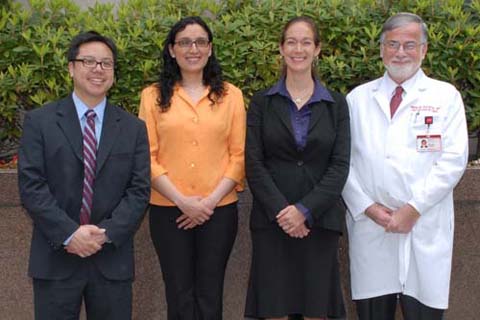Congrats to Pioneers of Novel Master's Program in Global Health:
Graduate Wins First Prize at DOM Investigator Award Event
June 13, 2011

(L to R) Drs. Cheung, Guzman, Downs, and Chairman Andrew I. Schafer. Dr. Downs is the CTSC two-year KL2 Scholar ($256,000).
Dr. Jennifer Downs was one of the "first" of four to graduate from a novel Global Health Track of the Master's of Science Degree in Clinical Epidemiology and Health Services Research. This program is a proactive collaboration between the Department of Medicine's Division of Clinical Epidemiology and Evaluative Sciences Research and the Center for Global Health in the Division of Infectious Diseases. She is also the NIH-funded Clinical and Translational Science Center (CTSC) KL2 Scholar in Global Health (two-year award, effective July 2010, for $256,000). Dr. Downs' thesis, a research study targeted to women in Tanzania of reproductive age who have schistosomiasis, resulted in a paper published in the American Journal of Tropical Medicine and Hygiene (March 2011). She received First Prize for this work at the 20th Annual Department of Medicine Investigator Award event (sponsored by The Michael Wolk Heart Foundation) on May 24, 2011.
 Dr. Downs, the CTSC two-year KL2 Scholar ($256,000) in Tanzania.
Dr. Downs, the CTSC two-year KL2 Scholar ($256,000) in Tanzania.
The first four pioneers to graduate from the new Global Health Track in the MS program include: Drs. Ricardo Riccio Oliveira (2010), Macarthur Charles (2011), Cynthia Riviere (2011) and Jennifer Downs (2011). The program is open to both physicians from the US and the Department of Medicine's extramural sites in Brazil, Haiti, India, South Africa, and Tanzania. By taking intensive block courses and returning to conduct their research, candidates remain an integral part of their home institution, and so, can continue with clinical and teaching responsibilities. International trainees remain engaged in their own county, and there is no risk of "brain-drain."
"Whatever you're interested in with this program they work with you. The program begins in the summertime and is so well adapted for students of global health. We were able to come together in New York to take courses and then go back to Brazil, Haiti, or Tanzania to conduct our research," says Dr. Downs. "Two intensive months in the summer to begin formulating our projects, and then by the end of the summer, we had designed them all. I wanted to go to Tanzania and I was able to choose my own research project. My key mentors were Dr. Daniel Fitzgerald and Dr. Warren Johnson, Jr."
SKYPING is fun..."The mentorship experience has been tremendous. One of the best things about this program is the Advanced Seminar, an ongoing course held throughout the two to three year program. Every Friday we get to SKYPE with our mentors, including Drs. Mary Charlson, Carol Mancuso and others. Internet in Tanzania doesn't allow us to see faces, but we can all hear each other while reviewing slides. You're held accountable for your work and have the opportunity to present your progress every six weeks or so."
Learning the structu..."Working with so many tremendous mentors, such as Dr. Charlson, has afforded a unique experience in structuring a research project from an evaluative sciences prospective. I didn't come into this program really knowing anything about data management, data analysis, or statistics. You have all these great ideas, but we're asking: How do we make a database to analyze all of this data we're collecting from the patients? So, we receive a lot of courses geared toward practical activities. My long-term goal is to be an internationally clinically-oriented researcher; this practical training in statistics and database management has been invaluable, exactly what I needed for the rest of my career."
First Prize...Dr. Down's received first prize at the Department of Medicine Investigator Award event on May 24, 2011. She presented the results of her published paper, "Urogenital schistosomiasis in women of reproductive age in Tanzania's Lake Victoria region," work based on the data she collected from examining hundreds of women in the Lake Victoria region. Her project revealed a connection between schistosomiais and HIV infection in this population of women. The germ of the project began during a conversation with one of her mentors, Dr. Johnson, who gave her some invaluable advice: "He said if you're going to be living and researching in some place, then pick a disease that's there. He mentioned schistosomiasis was very prevalent in the Lake Victoria region." This conversation jump-started the process for Dr. Downs, with an initial literature search at the library.
"Understandably, due to financial limitations, Tanzania had focused on children with schistosomiasis. This project would give me an opportunity to study the disease in adult women. Children get the disease from swimming in infected water. But adult women are also exposed; for instance, washing laundry. I was able to help a group of women who had been underdiagnosed and undertreated. It was a wonderful experience knowing them. This research project has been both scientifically interesting and personally compelling."
Conclusions cited in the paper include a call for future public health interventions to treat these young women who also have the highest risk for incident HIV infection. Schistosomiasis, caused by a parasitic worm and contracted via infected water, is considered one of the world's most socioeconomically devastating diseases.